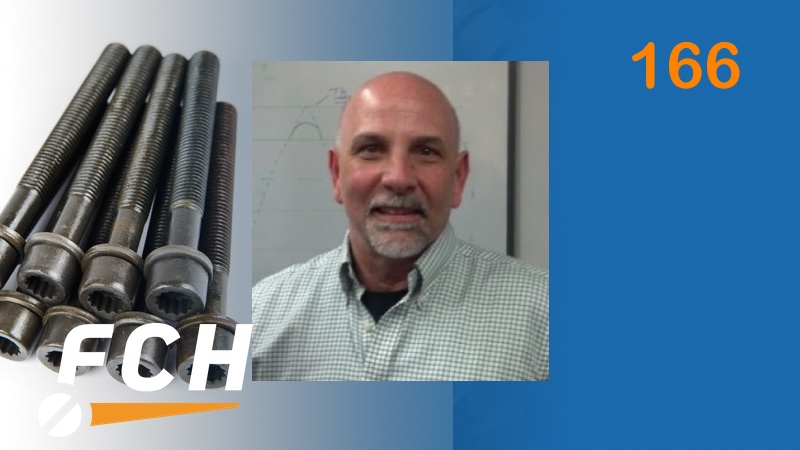This edition of the Fastener Training Minute with Carmen Vertullo was originally published July 17, 2021 as “What do you do when a customer rejects a product based on a requirement, that was not part of the original specification? ” during episode 166 of Fully Threaded Radio.
Well hello everyone, This is Carmen Vertullo with your Fastener Training Minute, coming to you from the Fastener Training Institute and the AIM Testing Laboratory in beautiful El Cajon California. As with many of my Fastener Training Minute topics, this one came from an email question from a client of ours. And surprise surprise, at the root of the question was hydrogen embrittlement.
This lesson is not about hydrogen embrittlement, it’s about something else that has to do with what to do when a customer rejects a product based on a requirement, that was not part of the original inquiry or the specification that governs the product. How do you handle that? And when we return, I’ll tell you the story and maybe give you some information about how to properly teach or the train your customers to not expect what is unreasonable, when they buy commercial products.
Well, welcome back to the faster training minute. This is Carmen Vertullo and today we’re talking about situations that involve unrealistic expectations from an uninformed customer about commercial fastening products. In this particular situation, I got an email from a client for whom we had conducted some hydrogen embrittlement testing on some commercial socket head cap screws that were black zinc-plated. These were very high quality socket screws, theoretically provided by one of what is considered to be the high end, quality product providers in the socket head cap, screw space. These were ASTM A574 socket head cap screws. I think they were about 3/8 x 2 1/2 and they passed the hydrogen embrittlement test. My client went on to ship them overseas to the military of another country.
And one of the things, those military folks did is they took those socket head cap screws, and they subjected them to a test for internal and external flaws, and that test was a magnetic particle inspection. The magnetic particle inspection, is a fluorescence inspection with small steel particles in a magnetic field that’s designed to see surface flaws and subsurface flaws that the human eye can’t see. They found one of these parts had a longitudinal indication (that’s what we call it when we find one of these flaws, we call it an indication), of a seam in this part. And a seam is a thing that happens in material when we cold form it, or draw wire, where the material kind of folds over on itself. And this just makes a beautiful green line right down the side of the part, from the head all the way through the threads.
And so they want to reject this product. Well, sadly or maybe fortunately, depending on what side of this equation you’re on, there is no requirement for this magnetic. Particle inspection anywhere in the customer’s inquiry nor on the governing standard which is ASTM A574. In fact, ASTM A574 allows for seams in the product. It’s not necessarily a rejectable discontinuity, depending upon how large and how deep the seam is.
So what to do? Now, the customer says, “hey, you shipped me crappy parts”. But what you did is you met the requirement of the purchase order. And now, the key is to train the customer to understand that when they require a product, that meets a level of quality, whether it’s something like a Magnetic Particle Inspection, or certain dimensional requirements that are not included in the standard, they should inform you of that prior to placing the order or during the quotation process, let’s say, and then you can accommodate them with a product that’s not likely to get rejected when they get it in their hands because you will have performed that requirement prior to shipping the product.
In this case, the product could have easily been Magnetic Particle Inspected, it’s not that expensive of an inspection. If we find any bad parts, we throw them out and maybe we throw out the whole lot, but we certainly threw out the bad ones, and then they are not going to have that problem.
So the customer presents an unrealistic expectation, and to be honest with you, if they’re uninformed, they are going to have a hard time being told that there’s nothing wrong with the product that they just found this indication on.
So there are two ways you can do that one. If you understand the specification, well you can simply take your IFI online book of Standards out. And cut that piece out of the standard and highlight it and send it to them. That says, exactly, what is required of the standard and what isn’t required. Inform them, how happy you are to be able to meet their requirements, when they are stated at the time of the purchase order. Most folks are reasonable and they don’t mind being educated or informed. And the next time the order comes up, everything goes smoothly.
So that’s the way that is. In this case, of course, my customer panicked and thought, oh crap, they sent us bad parts. No one sent you bad parts: you got what you ordered and you provided the end-user what they ordered.
The problem was the end-user didn’t order what they needed. So that’s how that works. I hope that was helpful to you at that happens and all kinds of other circumstances, dimensional things. Other things where the client or the customer has an unrealistic expectation of a commercial fastening product.
Well, this has been Carmen Vertullo with your Fastener Training Minute, I hope you learned something.




![[GC2610] Solution_FCH Banner_[220x100] copy](https://news.fastenersclearinghouse.com/wp-content/uploads/2025/09/banner_solutionind.jpg)

